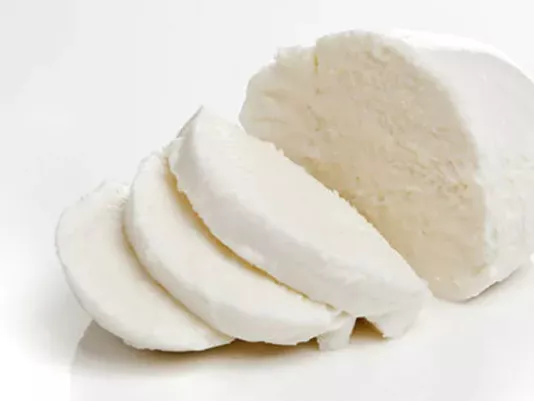Cold Pasta with Spinach Pesto
Cold pasta with spinach pesto is an Italian recipe that is prepared in the summer.

Mozzarella is one of the most delicate cheeses I work with in the kitchen. Its tender, slightly fibrous texture, juiciness, and natural creamy flavor create countless culinary combinations. I add mozzarella to salads with tomatoes, basil, and olive oil, use it as a base for pizza, put it in lasagna and appetizers, or simply serve it with fruit. I particularly like the small ball format – it’s perfect for individual dishes and festive presentation. Mozzarella responds well to heat – it melts into a soft, stretchy texture without losing its tenderness. It works wonderfully in both hot and cold dishes. Besides classic mozzarella, I also use burrata – with its creamy center – for more refined presentations. No matter the format, this cheese is my go-to choice for light, fresh, yet rich meals. It doesn’t overpower other flavors – instead, it highlights and balances them. That’s why mozzarella is a staple in my fridge.
Mozzarella is the ideal cheese for cold dishes – especially salads. The most famous example is Caprese salad, which combines mozzarella, tomatoes, fresh basil, and olive oil. I often make it in the classic style or with additions like arugula, roasted peppers, or even berries like strawberries – they add a pleasantly sweet accent. In salads, mozzarella doesn’t compete with other ingredients – it brings them together in a harmonious ensemble. In modern cooking, there are many variations: I prepare salads with mozzarella and roasted pumpkin, quinoa, grilled vegetables, prosciutto, or even pan-fried grapes. I particularly like using mozzarella balls (bocconcini or ciliegine) – they’re compact, easy to serve, and delicately flavored. Because of their soft texture, these cheeses easily absorb aromas – I often marinate them for a few hours in oil with spices, garlic, and lemon zest to give the salad a special nuance. Mozzarella salads always look festive and refreshing in any season.
One of mozzarella’s greatest strengths is its ability to melt into a soft, stretchy texture. That’s why I frequently add it to casseroles, lasagna, stuffed vegetables, and pasta. In lasagna, mozzarella pairs perfectly with ricotta, tomato sauce, and meat or vegetables, forming a gooey cheese layer that unifies everything. I love adding it to eggplants or zucchini baked with tomato sauce – a lighter but very flavorful take on classic Italian dishes. In pasta bakes – like penne or farfalle – mozzarella melts over the pasta and vegetables, creating a creamy topping. I also use it in potato or mushroom casseroles – it helps hold everything together and brings a soft touch even to the simplest ingredients. In skillet dishes like vegetable sauté or eggs, placing a few slices of mozzarella at the end creates a delicious melted center. This simple step takes a regular meal to the next level.
Mozzarella is a key ingredient in pizza – it’s what gives us that signature golden, stretchy cheese topping everyone loves. For traditional Italian pizza, I choose fior di latte or buffalo mozzarella – they’re less watery, melt better, and won’t soak the crust. I use mozzarella not just in Margherita, but also in pizzas with prosciutto, mushrooms, artichokes, roasted peppers, or anchovies – its gentle flavor balances out bold toppings. Besides pizza, I add mozzarella to focaccia and savory breads. It works both as a filling and as a topping that browns nicely and adds texture. In baked goods made with puff or yeast dough – like savory rolls, cheese buns, or tartlets – mozzarella ties all the flavors together and adds moisture. I also experiment with mini calzones filled with tomatoes, basil, and mozzarella. Thanks to its softness and neutrality, this cheese makes a versatile filling that doesn’t require many spices or complex techniques.
Mozzarella is simply indispensable for appetizers. It’s easy to slice or use in small ball form to create light, elegant dishes for parties or buffets. I often make skewered canapés with mozzarella, cherry tomatoes, and basil – a classic that always pleases. Or I wrap mozzarella balls in slices of prosciutto, adding grapes or figs – the sweet-salty combo is perfectly balanced. I also make eggplant or zucchini rolls stuffed with mozzarella, herbs, and nuts. They look festive and can be served warm or cold. In this form, mozzarella doesn’t leak, stays soft, and adds richness. Another idea is to stuff cherry tomatoes or peppers with mozzarella and herbs. These miniature bites can be made ahead and served before the main course. Even in sandwiches or paninis, mozzarella shines – it melts, binds the ingredients, and creates that comforting “cozy” effect that’s so beloved in appetizers.
Mozzarella quality makes a big difference – it affects both the taste and texture of your dishes. The softest is buffalo mozzarella, made from buffalo milk: it has a more pronounced flavor, creamier texture, and is perfect for fresh dishes or salads. Classic cow’s milk mozzarella (fior di latte) is firmer – great for slicing, baking, or melting. There’s also shredded mozzarella sticks – convenient for pizza and hot dishes, though less juicy. I always store mozzarella in its original brine or liquid. Once opened, I use it within 1-2 days – it quickly loses its softness. Avoid leaving mozzarella without liquid – it dries out and becomes rubbery. When cooking, I pay attention to the cheese’s moisture level: less moist options are better for pizza, while juicier ones suit salads. In terms of pairing, mozzarella “loves” simple flavors: olive oil, tomatoes, basil, balsamic vinegar, prosciutto, fruit. It’s like a blank canvas, ready to be enhanced to your taste. That’s exactly why mozzarella is such a valuable ingredient in modern cooking.